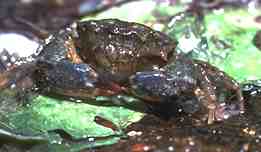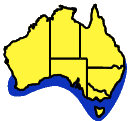|
|
Smooth-handed Crab, Pilumnopeus serratifrons
Form:
 This
is a small, globe-shaped crab with a hairy covering on its legs while
the carapace has few hairs.
This
is a small, globe-shaped crab with a hairy covering on its legs while
the carapace has few hairs.
The male crab has very large equal-sized chelae. The carapace has three broad spikes, called teeth behind the eye. The walking legs and chelae do not have any spines. It has very short eyestalks.
Colour:
This crab is purple-brown above with a mottled pattern It has pale brown to yellow chelae. The fingers of the chelae are distinctly coloured black, tipped with pale brown..
Phylum: |
Arthropoda |
Author: |
|
Family: |
Pilumnidae |
Size: |
25 to 30 mm |
Distribution:
 The
Smooth-handed Crab ranges from Queensland, around the southern shores
to the Swan River in Western Australia.
The
Smooth-handed Crab ranges from Queensland, around the southern shores
to the Swan River in Western Australia.
Habitat:
It is common among seagrasses on tidal flats, in estuaries and among rock and wood structures.
Biology:
Camouflage, or protective behaviour
When disturbed, the Smooth-handed Crab will not attempt to try and scuttle away but instead folds its legs tightly underneath its body and pretends that it is a pebble.
Parasitism
Male Smooth-handed Crabs, Pilumnopeus serratifrons, can be parasitised by a species of shelless Barnacle Saccula sp. which lives part of its life cycle under the male's abdominal plate. The parasitic barnacle feeds on the living crab's tissue.
Click here for a detailed description of this parasitism.
References:
Barnes, R. D. (1968) Invertebrate Zoology. p. 467, W.B. Saunders Company, Philadelphia.
Bennett, I. (1987) W.J. Dakin's classic study: Australian Seashores. p.391, Angus & Robertson, Sydney.
Davey, K. (1998) A Photographic Guide to Seashore Life of Australia. p.52, New Holland, Sydney.
Jones, D. & Morgan, G. (1994) A Field Guide to Crustaceans of Australian Waters. p.182, Reed, Chatswood.
Crabs
Tubercled
Crab
Reef Crab
Smooth-handed Crab
Variegated
Shore Crab
Red Bait Crab
Sowrie Crab
Mudflat Sentinal Crab
Smooth Shore Crab
Seaweed-decorator
Crab
Crab
reproduction
Crab parasitism
Home
Page
Taxonomy
Biogeography
Rocky Shores
Tidal Levels
Intertidal Zonation
Environmental Factors
Biological
Factors
Feeding Relationships
Activities
Glossary
References
 Life
on Australian Seashores
Life
on Australian Seashores
by Keith Davey (C) 2000
Learning Consultant
- Media
The University of Newcastle
email at australian_seashores@hotmail.com
Scientific Consultant: Phil
Colman
site created 01.01.98 : updated 01.04.2000
